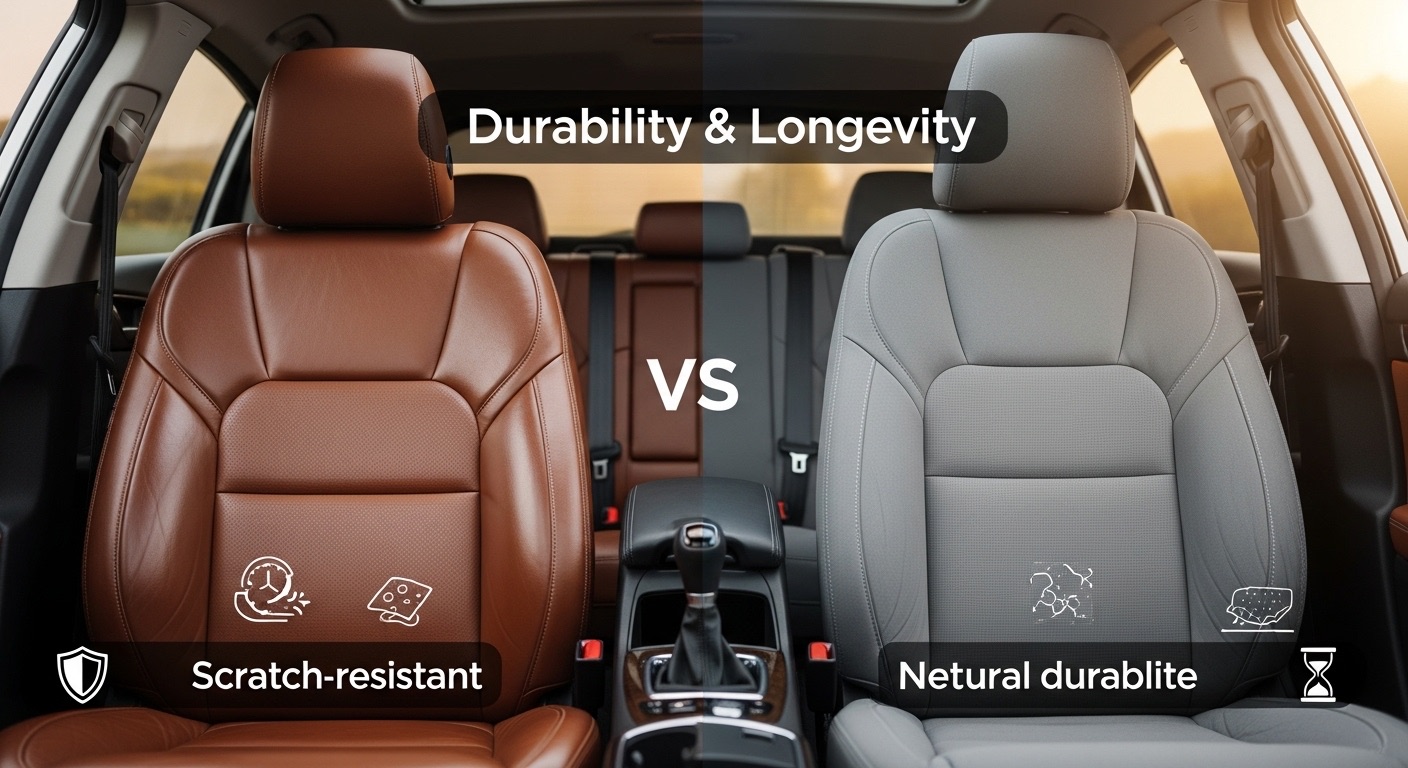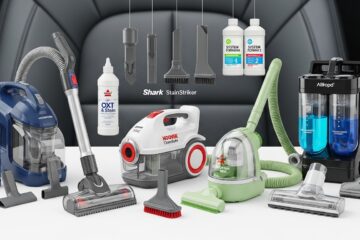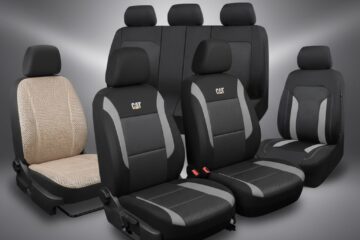Choosing the interior of your new car is a major decision, and nothing defines the cabin experience quite like the seats. The classic dilemma—leather seats vs fabric seats—often leaves buyers stuck. One promises luxury and easy cleanup, while the other offers comfort and affordability. But which one is truly better for your lifestyle, budget, and long-term satisfaction?
The confusion is understandable. Dealerships often frame leather as a non-negotiable premium upgrade, while online forums are filled with conflicting opinions. As an automotive content expert who has spent years testing, owning, and evaluating vehicles with both upholstery types, I’m here to cut through the noise. This detailed guide will provide a clear, expert-backed comparison with real-world insights to help you make a well-informed decision.
Quick Comparison: Leather vs. Fabric Seats
| Factor | Leather Seats | Fabric Seats |
|---|---|---|
| Price | Higher initial cost (often a 1,500−1,500−3,000+ upgrade) | Standard on most models; lower cost |
| Durability | Excellent against spills; prone to cracking/fading if not maintained | Prone to staining; resistant to punctures and extreme temperature damage |
| Comfort | Can feel hot in summer and cold in winter | More breathable; stays at a more neutral temperature |
| Maintenance | Easy to wipe clean; requires periodic conditioning | Harder to clean stains; requires vacuuming and occasional deep cleaning |
| Appearance | Sleek, premium, and luxurious | Cozy, practical, and available in more patterns/colors |
| Resale Value | Can slightly increase a car’s resale value | Generally has a neutral or minimal impact on resale value |
What Are Leather Seats?
In simple terms, leather seats are upholstered with treated animal hides, most commonly from cattle. This material is known for its smooth finish, distinct smell, and association with high-end luxury.
Modern automotive leather comes in various forms, from genuine and Nappa leather (a softer, higher-quality version) to synthetic or vegan leather (often called “Leatherette”), which mimics the look and feel of the real thing at a lower cost and with different durability characteristics. For this comparison, we’ll focus primarily on genuine leather.
Key Features:
- Premium look and feel
- High stain resistance
- Generally considered more durable against wear
- Hypoallergenic properties
What Are Fabric Seats?
Fabric seats, also known as cloth seats, are the standard option in most vehicles. They are typically made from durable synthetic materials like nylon, polyester, or a blend that’s designed to withstand years of use.
Unlike leather, which is a single type of surface, fabric upholstery comes in a vast array of weaves, textures, and patterns. From soft, velour-like materials to rugged, canvas-like weaves found in off-road vehicles, fabric offers a wide range of aesthetic and functional choices.
Key Features:
- Affordable and cost-effective
- Breathable and comfortable in extreme temperatures
- Soft and inviting texture
- Wide variety of design options
Side-by-Side Comparison: Leather Seats vs Fabric Seats
Let’s break down the key differences to see how these two options stack up in the real world.

Durability and Longevity
Leather is incredibly tough and resistant to daily wear. Its smooth, non-porous surface means spills often bead up, allowing you to wipe them away before they soak in. However, its longevity is directly tied to maintenance. Without regular cleaning and conditioning, leather can dry out, crack, and fade from UV exposure.
Fabric seats are less susceptible to cracking or scratching from keys or rivets on pants. Their main vulnerability is staining and absorbing odors. A spilled coffee or a muddy pet can create a lasting mark if not treated immediately and properly. High-quality fabric is very durable but may show fraying or thinning after many years of use.
Cost and Value
There is no contest here: fabric seats are significantly more affordable. They are the standard option on base and mid-trim models, meaning you pay nothing extra. Leather is almost always an optional upgrade, often bundled into packages that can cost thousands of dollars.
However, leather can offer better long-term value. Cars with leather interiors often command a slightly higher resale value, as they are more desirable in the used car market. You won’t recoup the full cost of the upgrade, but it can make your car more attractive to potential buyers down the line.
Comfort and Breathability
This is where fabric seats truly shine. Fabric is a breathable material, which allows air to circulate. This means it stays cooler to the touch after sitting in the sun and doesn’t feel shockingly cold on a winter morning.
Leather, on the other hand, absorbs and retains temperature. On a hot day, it can become scorching hot, leading to the dreaded “leg peel” when wearing shorts. In the winter, it can feel icy cold. Many modern cars mitigate this with heated and ventilated seats, but that adds even more to the cost.

Maintenance and Ease of Cleaning
For spills and messes, leather is the undisputed champion. A dropped ice cream cone, a splash of soda, or a muddy paw print can usually be wiped clean with a damp cloth, leaving no trace behind. This makes leather a top choice for families with young children.
Fabric is like a sponge. It absorbs liquids quickly, making stains a major concern. Cleaning requires specialized upholstery cleaners, a good brush, and often a wet/dry vacuum to fully extract the mess. Fabric also traps dust, pet hair, and allergens more easily, requiring frequent vacuuming.
Appearance and Aesthetics
Appearance is subjective, but each material has a distinct look. Leather offers a sleek, uniform, and luxurious aesthetic that elevates the feel of any car interior. It’s the universal symbol of a premium cabin.
Fabric seats provide a cozier, more casual, and often more personalized look. With a wider range of available colors, patterns, and textures, fabric can feel more inviting and less formal.
Health and Allergens
For allergy sufferers, leather is the superior choice. Its solid surface doesn’t trap dust mites, pet dander, pollen, or other allergens. A quick wipe-down effectively removes them from the cabin.
Fabric seats, due to their woven nature, can act as a filter, trapping these very same allergens deep within the fibers. This can be a significant issue for individuals with respiratory sensitivities or severe allergies.
Pros and Cons: A Clear Breakdown
| Leather Seats | Fabric Seats |
|---|---|
| Pros | Pros |
| ✔️ Premium, luxurious appearance | ✔️ Significantly lower initial cost |
| ✔️ Very easy to clean spills | ✔️ More comfortable in extreme temperatures |
| ✔️ Hypoallergenic; doesn’t trap dust/dander | ✔️ Breathable material |
| ✔️ Can increase resale value | ✔️ Wide variety of colors and textures |
| Cons | Cons |
| ❌ High initial cost | ❌ Prone to staining from spills |
| ❌ Gets extremely hot/cold | ❌ Can trap allergens, dust, and odors |
| ❌ Requires conditioning to prevent cracks | ❌ More difficult to deep clean |
| ❌ Can be punctured or scratched by sharp objects | ❌ Generally seen as less premium |
My Expert Take: Real-World Experience with Both
Having driven and lived with cars featuring both interiors for years, I can tell you the “best” choice truly depends on your daily life. My last family vehicle had leather seats, and as a parent of two, they were a lifesaver. From spilled juice boxes to crushed crackers, a 30-second cleanup was all it took to make the interior look new again. The peace of mind was worth the price.
However, I’ll never forget that searing hot Texas summer afternoon when the black leather felt like a branding iron. In my current commuter car, I opted for high-quality fabric. The cost savings were substantial, and I never have to worry about temperature extremes. The trade-off? I am religious about my “no food or drinks” rule in that car, as I know one major spill could lead to a permanent, frustrating stain. The fabric also holds onto dog hair from my golden retriever far more than leather ever did.
My takeaway: Leather’s convenience for messes is real, but so is its temperature sensitivity. Fabric’s comfort is undeniable, but its vulnerability to stains is a constant, low-level worry.
Buying Guide: Which Upholstery is Right for You?
Let’s match you with the right option based on your needs.
For the Family with Young Kids…
Winner: Leather. The sheer ease of cleaning up spills, dirt, and food makes leather the hands-down winner. The long-term cost of professionally cleaning fabric seats after inevitable accidents could quickly add up.
For the Budget-Conscious Buyer…
Winner: Fabric. Fabric is the standard, no-cost option. It allows you to get into a new car without adding thousands to the price tag for an aesthetic upgrade, freeing up your budget for other features like safety tech or a better engine.
For the Pet Owner…
It’s a Tie (with caveats). Leather is fantastic for cleaning up pet hair and muddy paws. However, sharp claws can easily cause permanent scratches or punctures. Fabric is less likely to get scratched, but hair weaves itself into the fibers and can be a nightmare to remove. Your choice depends on whether you’re more worried about claws or hair/messes.
For the Luxury Seeker…
Winner: Leather. Nothing communicates a premium, high-end feel like a leather interior. It enhances the look, feel, and even the smell of a car cabin, contributing to a more luxurious ownership experience and better resale value.
For Those in Extreme Climates…
Winner: Fabric. If you live somewhere with blistering summers or freezing winters and your car won’t have heated/ventilated seats, fabric is the more comfortable day-to-day choice. It remains at a far more neutral and pleasant temperature year-round.
The Final Verdict: Leather Seats vs Fabric Seats
At the end of the day, the debate of leather seats vs fabric seats comes down to a simple trade-off: convenience vs. comfort and cost.
Choose leather if your top priorities are a premium aesthetic, maximum ease of cleaning, and improved resale value, and you are willing to pay the price for it, both in dollars and in temperature sensitivity.
Choose fabric if you are focused on initial affordability, year-round comfort, and a softer, cozier feel, and you are diligent enough to prevent major stains or clean them promptly.
The best choice isn’t universal; it’s personal. Evaluate your daily routine, your passengers (both human and furry), your climate, and your budget. By prioritizing what matters most to you, you’ll make a decision that you’ll be happy with for years to come.
Just like choosing the right seats is key for long-term satisfaction, so is understanding the lifespan of other critical components. For instance, being prepared for a replacement by knowing how long a typical car battery lasts is a vital part of smart car ownership.
Frequently Asked Questions (FAQ)
Do leather seats really increase a car’s resale value?
Yes, but modestly. A car with a well-maintained leather interior is often more desirable on the used market and can command a slightly higher price than the same model with fabric seats. However, you typically won’t recoup the full initial cost of the leather upgrade upon resale.
Is fabric or leather better for dogs?
It depends on your dog. Leather is easier to clean hair and dirt from, but claws can cause permanent scratches. Fabric doesn’t scratch easily, but it traps hair and absorbs odors and “accidents” more readily. A high-quality seat cover is recommended for dog owners regardless of the material.
How long do fabric car seats last?
With proper care, high-quality fabric seats can easily last 5-10 years or more without significant issues. Their lifespan depends on factors like sun exposure (which can cause fading), frequency of use, and how quickly stains are treated. The main issues over time are typically staining and thinning/fraying in high-contact areas.




